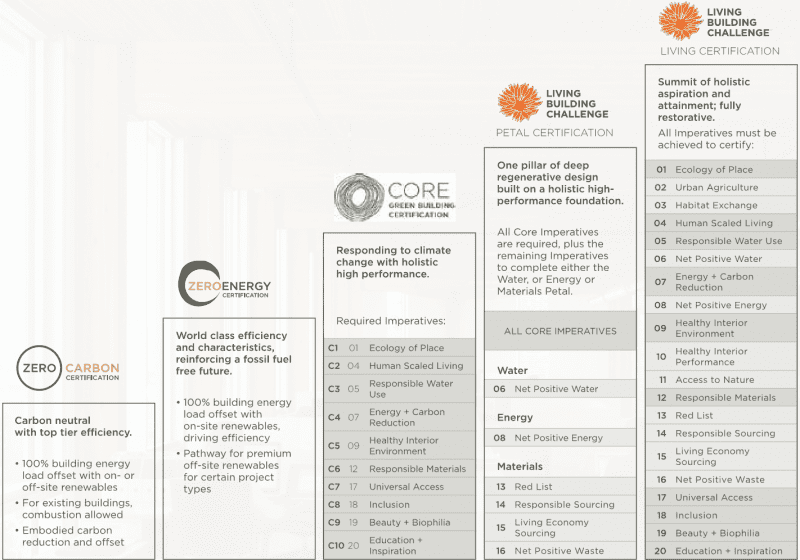Miller Hull
- Portfolio
- Approach
- News
Events
Posted August 18, 2025
- About
- Connect
Perspectives. It’s time to do more to help save our environment
5-17-2019 | Perspectives
By Chris Hellstern, AIA, LFA, LEED AP BD+C, CDT
Living Building Challenge Services Director
Urgency. That is one of the biggest take-aways from this year’s Living Future Conference hosted in Seattle by the International Living Future Institute (ILFI). This was my 11th consecutive attendance at a Living Future and it has been enjoyable and rejuvenating to participate in the evolution over the years.
Along with Partner Rob Misel and Principal Margaret Sprug, we presented both a session and a workshop at this year’s conference. While there was the ever-present infusion of inspiration at this year’s conference, it was primarily focused on the technical side. The conference always brings with it the great pleasure to be able to reconnect with so many friends and colleagues around the world who are doing amazing work to improve our built environment.
While the conference can sometimes be criticized by having too many messages that preach to the choir, ILFI founder and Board Chair Jason F. McLennan likes to say, “Sometimes the choir needs to get together to practice.”
This year, ILFI took the necessary step of updating the Living Building Challenge (LBC) to version 4.0. This revision provides projects with more of an ability to implement Living Building solutions at scale. These changes include stepping away from some of the more prescriptive requirements and focusing on performance outcomes like “contributing positively to the ecology” and helping to “restore or enhance the ecological performance of the site.” Other Imperatives from the Challenge did receive their fair share of prescriptive updates too, as in the case of specific embodied carbon reduction for building materials in a project. This goes beyond the blanket offset-only of previous Challenge versions. The Materials Petal made improvements also with the intent of reducing large efforts of materials vetting that can sometimes only return minimal results.
Most impactfully, the Red List now targets chemical classes rather than individual chemicals and incorporates a Red List watch list. These changes help to address chemicals of concern at a larger and faster scale and more closely align with some nation-leading legislation that was just passed in Washington state, for example. Overall, the improvements to the Challenge will be beneficial to individual projects and the larger market, in general. Living Buildings continue to both push and pull the design, construction and manufacturing industry and this revised version of the Challenge will help expand that even further.

Figure 1 provided by the International Living Future Institute
ILFI also rolled out a new rating system, CORE Green Building Certification. This system is intended to fill the gap between LEED Platinum and LBC Petal Certification and when compared to only ILFI programs, fits in as a step between Zero Energy Certification and Petal Certification. (See Figure 1) Like the many other updates provided at this conference, this new system is intended to help scale the program and identify the core best practices that every project should be achieving. Participation commitment from Google, King County in Washington, and one of our own projects, The BLOCK Project, in volume certification of these programs certainly helps begin to drive this change.
From Bill McKibben’s conference-opening keynote to one of the final sessions of the conference with AIA COTE’s Top 10 Toolkit (which Miller Hull contributed to), the message was clear—we must all do more good than we’ve been doing and we must do it sooner.
Just the following Monday after the conference concluded, the world received two dire reports that supports this. One is that we have hit a record level of CO2 in our atmosphere since humans have been on the planet. But perhaps more alarmingly, a new UN report concludes that we are facing a massive extinction of one million species on our planet because of human activity. This human-caused extinction will take the planet millions of years to recover the loss of biodiversity and this crisis is already unfolding and could reach this predicted loss level in mere decades.
While the current ecological crises we face from increased CO2 to the loss of biodiversity are immense problems and it is easy to feel overwhelmed, we must also remember that inaction is not a choice. We all have our own ways to better care for our planet. And as Bill McKibben called us to do, our efforts cannot stop with our 9-5 work days, but they must also happen on nights and weekends. Our choices matter and if we all pull in the right direction together, we can turn things around.
Chris Hellstern is Miller Hull’s Living Building Challenge Services Director. He’s the recipient of ILFI’s Hero award in 2012 and has been designing certified Living Buildings since 2009.
Related Articles
Miller Hull Partnership and Lord Aeck Sargent Complete Ultra-Sustainable Building at Georgia Tech
By Fred A. Bernstein To generate at least as much energy as it uses, a building…
11-8-2019 | News
Interior Design’s 2023 Best of Year Award Winners
New U.S. Embassy in Niamey, Niger is a 2023 Best of Year Award Honoree. Interior Design’s…
12-8-2023 | News
04/2017 Miller Hull hosts Sustainable Forestry Event
In collaboration with Sustainable Northwest Wood and McLennan Design, we're hosting a Sustainable Forestry event bringing together…
4-26-2017 | Events
Revisiting Afghanistan’s Gohar Khatoon Girls School Under Taliban Rule
By Yasaman Esmaili, Solaiman Salahi When it opened in the city of Mazar-i-Sharif (Mazar), in the northern part…
5-10-2022 | News
Miller Hull is now accepting applications for our 2019 Open Studio program in Seattle
NEW DEADLINE: Internship applications are due Friday, June 21st. Intensive applications are due Sunday, June 30th.…
5-28-2019 | News
This Elevated Cabin in Washington’s Decatur Island is Built to Change with Time
Perched within the forest canopy of Washington’s Decatur Island in the Salish Sea is the Trestle Cabin,…
6-13-2025 | News
××